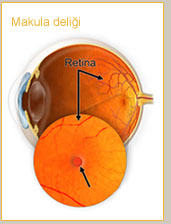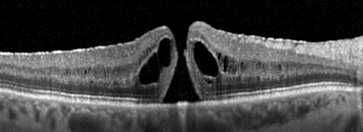Macular Hole

What is Macular Hole?
A macular hole is a break in the macula, which lies at the center of the retina and is responsible for sharp and color vision.
Who is at risk for macular hole?
Macular hole usually occurs in people over the age of 50, and approximately two-thirds are females.
What is the cause of Macular Hole?
Macular holes almost always develop during the natural aging process, when the vitreous (the gel that fills most of the eye) thins and separates from the macula. Residual vitreous humor remaining on the retinal surface after this event probably contracts, pulling on the macula and fovea in outward direction. This can cause a macular hole. Less commonly, macular holes are caused by eye injury, high myopia, intraocular inflammation, retinal detachment and some other eye diseases.
What are the symptoms of Macular Hole?
Macular hole may only cause a small blurry or distorted area in the center of vision at the beginning. As the hole grows over several weeks or months, central vision progressively worsens. People with a macular hole will have central visual changes. These changes can range from straight lines look like wavy or distorted (metamorphopsia) in the early stages to a blank patch (scotoma) in the center of vision in the late stages. Macular holes usually only affect one eye, though there is a 10 per cent chance that the other eye will eventually be affected. Peripheral vision is usually normal unless a retinal detachment occurs which is very rare.

Does Macular Hole cause permanent visual loss?
An untreated macular hole is one of the common causes of irreversible central visual loss in people over age fifty.
How is Macular Hole diagnosed?
For the diagnosis of macular hole, a routine eye examination is followed by posterior segment examination with pupil dilatation. Optical coherence tomography (OCT), using light waves to visualize the retina without any side effects, is performed in patients suspected of macular hole. OCT also allows detailed evaluation of the vitreomacular interface and outer retinal layers in the fellow eye for assessment of the risk of macular hole formation.
What is Macular Hole Treatment?
The surgery is the only treatment for the macular hole. Surgery is over 95% effective for the treatment of macular holes, but the final visual improvement may not be achieved for many months after surgery. The operation, called vitrectomy, is performed to remove the vitreous gel, and then a gas bubble is injected into the eye to help to close the hole. Head down positioning for about 5 days after surgery is required to maximize the effect of the macular hole repair. Over the period of two to six weeks, the bubble will gradually be reabsorbed as the vitreous cavity refills with naturally produced fluid.
What is the most common complication of Macular Hole Surgery?
The most common risk following macular hole surgery is a cataract development or progression.
Last Updated: October 23, 2024



























